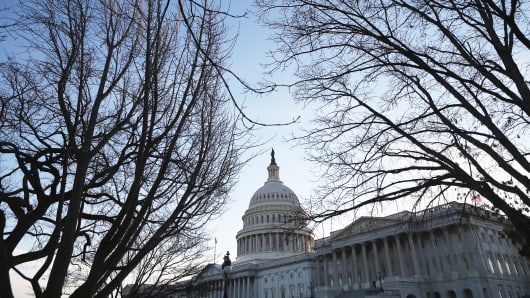Art Hogan, managing partner at Lazard Capital Markets, said investors' lack of concern over sequestration comes from three factors: A belief that Congress will find a last-second compromise, a la the cliff; less concern about the spending cuts than the tax increases; and "a lack of understanding over what this really means in terms of how much of a drag this is on GDP."
(Read More: Obama Speech Does Little to Prod Congress Toward Action)
Most economists pin the impact short of 1 percentage point, compared to the full cliff's potential impact of upwards of 4.5 percent.
"There's less hue and cry that something like the fiscal cliff is going to happen with delay," Hogan said. "What happens is more of a process where we either see success or failure in ongoing negotiations and debate - that kabuki theater that is done so well inside the beltway."
He thinks investors may be underestimating the potential market impact.
"You've got market participants who have been looking at this market up 10 percent since December and 6 percent on the year and are looking for reasons for a pullback," Hogan said. "This is by a long stretch the No.1 candidate for that pullback."
JPMorgan Chase recently cut its full-year gross domestic product forecast by about a quarter percentage point, to 1.9 percent, after backing off on what economist Michael Feroli said was a "hard to square" assumption that the spending cuts would be avoided.
But the firm remains bullish on the stock market, in part because the modest growth will be enough to continue a rally that has been fueled by another trillion dollars or so the Federal Reserve will pump into the market this year. The firm expects housing, construction and capital spending to fuel accelerating growth in the second half of 2013.
(Read More: Central Banks Gone Wild: What Can Investors Do?)
"We remain constructive but...we believe investors should be focusing on higher-quality as well as low-valuation stocks and small-cap as well," Thomas J. Lee, JPMorgan's chief market strategist, said in his weekly market note.
The only possible sign that markets care about the sequester is that this week the rally has seen a pause—but still no retreat.
Sentiment surveys and fund flows remain strongly bullish, and Citigroup's Panic/Euphoria model is near euphoria stage, according to Tobias Levkovich, Citi's chief equity strategist.
"Given potentially bitter fiscal policy battles linked to required tax and spending reforms in March, we expect some volatility in the next couple of months," Levkovich said in a report. "However, our outlook for 2013 remains attractive given signals from valuation, implied earnings growth and credit conditions to name a few factors."
-By CNBC.com's Jeff Cox. Follow him on Twitter at @JeffCoxCNBCcom.





